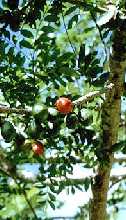View crop
View crop Data sheet EcoPortSpondias purpurea
 |
|
| Notes |
|---|
| BRIEF DESCRIPTION A small deciduous tree usually 6-10 m tall, but sometimes up to 25 m with a thick and gnarled trunk, 30-80 cm in diameter, stout branches, and spreading growth. The fruit is an oblongoid to ovoid drupe, 2.5-4 cm x 2 cm, purple-red, dark-purple or yellow, weighing 20-30 g. USES The fruit is eaten fresh, cooked, preserved, dried or made into jelly. The green fruits are used for pickles. Large stumps are planted as live fence posts. The wood can be used for paper pulp. Cattle eat the leaves. The bark have medicinal properties. It is mentioned as a possible agroforestry species. GROWING PERIOD Perennial. The tree require growing conditions with a marked dry season up to 6 months. It begins to bear 4-5 years after sowing. COMMON NAMES Red mombin, Hog plum, Cajote, Ciruela de hueso, Spanish plum, Spanish prune, Ciruela, Xocotl, Purple mombin, Jocote, Mombin rouge, Prunier d'Espagne, Prune d'Espagne, Prune cafe, Prune des Antilles, Jamaica plum, Scarlet plum, Cirguelo, Ciruela colorada, Ciruela comun, Ciruela del pais, Ciruela roja, Hobo, Hobo colorado, Jobillo, Jobito, Jacote comun, Ubo, Yocote, Caja, Ciriguela, Cirouela, Siniguelas, Sirihuelas, Sirigulas, Ateyaxocotl, Kedondong cocok. FURTHER INF Scientific synonyms: S. cirouela, S. myrobalanus, S. mombin, S. dulcis, Warmingia pauciflora. Red mombin is native of Central America and Mexico. In South-East Asia it thrives at elevations up to about 600 m, while in Central America it can be found at altitutes between sea level and 2000 m. It succeeds equally well in both dry and wet sites, but better fruit quality is apparently produced in places with a long dry season. | Sources |
| SOURCES (S. purpurea L.) Araque R 1966 IBPGR 1986 pp 18 Campbell C 1985 Tindall H 1986 pp 163 Fouque A 1972 Roecklein J 1987 pp 236 [USE, TEMP] Duke J 1975 pp 28 [TEMP, RAIN, PH] Purseglove J 1974 pp 18 [USE] Hensleigh T 1988 pp 302-304 [TEXT, FER, DRA, RAIN, USE] Bermejo J 1994 pp 111-115 [USE] Verheij E 1991 pp 288-290 [USE, TEXT] |